
EXTERIORS - WINDOWS

Windows
One of the biggest challenges historic building owners may face is the
treatment of old windows. Deferred maintenance and careless painting
over the years can result in rotting wood, missing hardware, and
draughty window that don’t open. Fortunately, repair is easier than you
may think.
Resources listed at the end of this section will help in that regard.
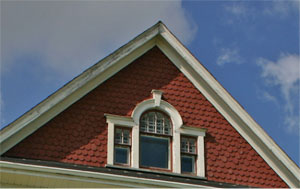
The unique window configuration, wide wooden
surrounds and distinctive
fish scale shingles work together to add important elements of
character to this fine brick home.
Frames
Retain and restore original window frames wherever possible. If parts
of a window are deteriorated, but other parts can be salvaged, consider
replacing only those elements that are damaged. This type of “selective
replacement” should be done with pieces milled to match the original as
closely as possible.
Replacement window frames for wooden windows should be of wooden
construction and dimensions should match the original windows. Any
decorative detailing on the original windows should be accurately
duplicated.
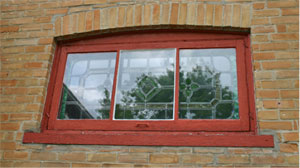
A little gentle scraping and a careful re-painting is all it will take
to maintain the look and authenticity of this window.
Sashes
Replacement sashes for wooden windows should be of wooden construction
and dimensions should match the original windows. Any decorative
detailing on the original sashes (such as muntins, mullions, and sash
frames) should be accurately duplicated. Similarly, replacements for
metal windows should be of metal construction.
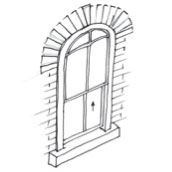 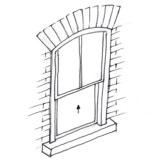 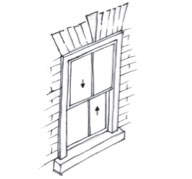
Fig 1. Square single or double hung window Fig 2.
Segmented arch single
hung window Fig 3. Arched single hung window
Hardware
Window type should match the original window. For example, original
double hung units should only be replaced with new double-hung window
units. The sizes of sashes and location of meeting rails should match
the original windows. Replacement windows should incorporate any
special features of the original windows, such as transom windows.
Window locks, latches, hinges, and cranks are made differently today
than in the past. The patina that develops on old hardware, or the
shine on a well-used door knob, is irreplaceable once lost. Consider
the heritage value of these holders of memory before discarding them.
Try the following resources to help you:
Working Windows: A Guide to the Repair and Restoration of Wood Windows,
by Terrance Meany, is an excellent, easy‐to‐follow guide aimed at
helping ordinary people with basic skills and no special tools to bring
even the most deteriorated, abused window back to beauty and utility.
Various editions are available, and the Winnipeg Public Library has
several copies.
If you wonder why you should keep your original windows instead of
replacing them with new ones, there are lots of sources that do the
math for you and explain the environmental and economic implications. A
good example is “What Replacement Windows Can’t Replace: The Real Cost
of Removing Historic Windows,“ by Walter Sedovic and Jill H. Gotthelf,
which was published in the Journal of Preservation Technology in 2005
and is easily found online by entering the title into a search engine.
The following articles are similarly available online and, though
perhaps not quite as down‐to‐earth as Working Windows, will give you
the information you need to fix your windows.
“Windows in Historic Buildings: Sustainable, Repairable,” by Susan D.
Turner (available on the Heritage Canada Foundation website).
“Maintenance and Repair of Historic Wood Windows” by Craig Sims and
Andrew Powter (also available from Heritage Canada).
Finally The U.S. National Park Service has produced an excellent series
of guides to the care of historic sites, which you can find by entering
the term “National Park Service Preservation Briefs” into an online
search engine.
Number 9 covers “The Repair of Historic Wooden Windows”, but don’t
hesitate to browse through the list for other topics of interest.
Most important to the character of the window is the size of the
opening and the materials of which it is made. Keep these two primary
concerns in mind when deciding upon windows for your historic building.
|

|
|
